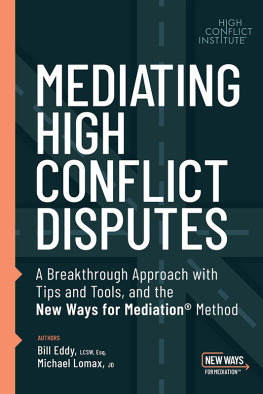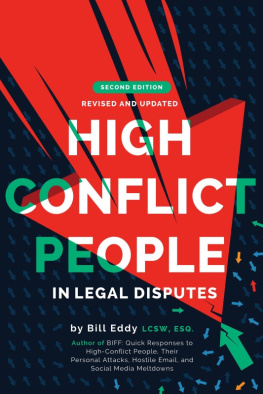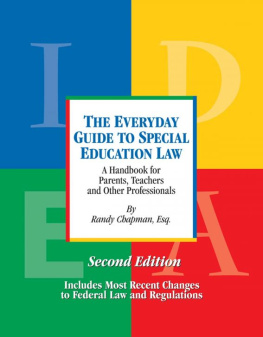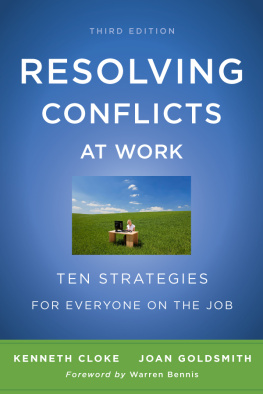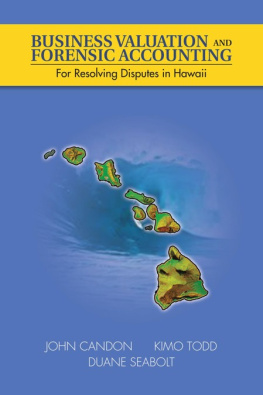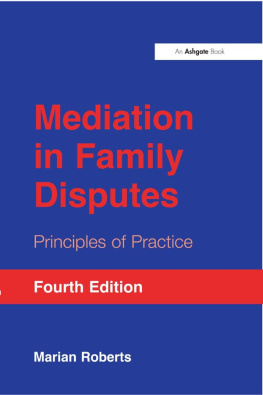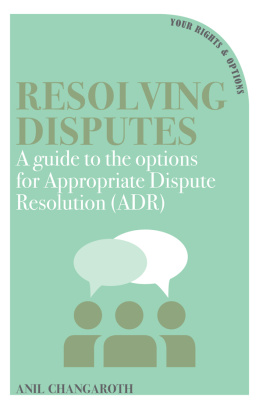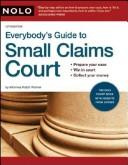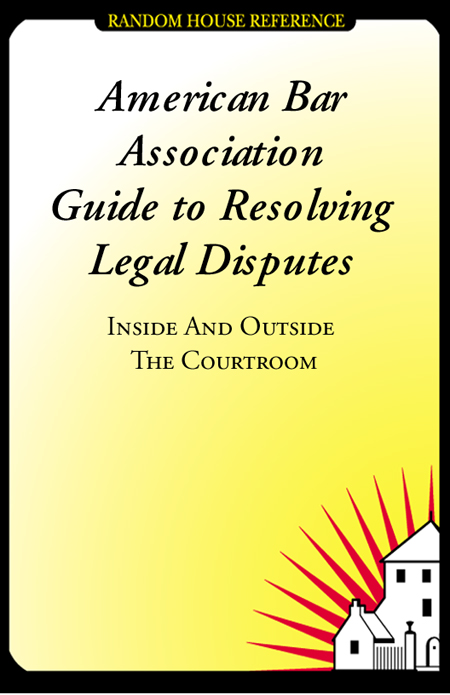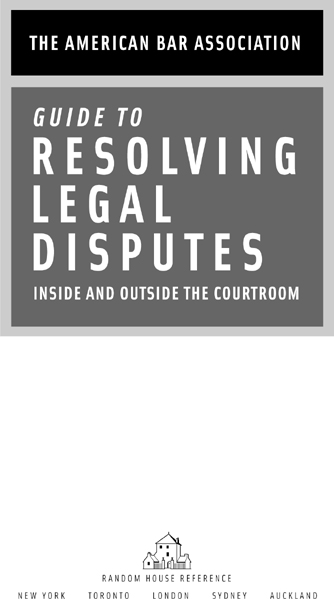American Bar Association

Henry F. White Jr.
Executive Director
Sarina A. Butler
Associate Executive Director, Communications Group
Mabel C. McKinney-Browning
Director, Division for Public Education
Katherine Fraser
Series Editor
S TANDING C OMMITTEE ON P UBLIC E DUCATION
Dwight L. Smith
Chair
A UTHOR
Sheila Maloney
Assistant Director, Program on Negotiation and Mediation
Clinical Assistant Professor of Law
Northwestern University School of Law
R EVIEWERS
Honorable Thomas H. Barland
Reserve Judge
Eau Claire, Wisconsin
Cheryl Cutrona
Executive Director
Good Shepherd Mediation
Program
Philadelphia, Pennsylvania
Joseph L. Daly
Professor of Law
Arbitrator/Mediator
Hamline University
School of Law
Saint Paul, Minnesota
Honorable Alvin Goldstein, Jr.
San Rafael, California
Jack Hanna
Director,
Criminal Justice Section
American Bar Association,
Washington, D.C.
Dr. Kathleen M. J. Harmon
President
Harmon/York Associates, Inc.
Secaucus, New Jersey
William Hornsby
Division for Legal Services
American Bar Association
Chicago, Illinois
Honorable Jerome E. LaBarre
Chair, Dispute Resolution
Committee, National
Conference of State Trial
Judges,
Multnomah County
Circuit Court
Portland, Oregon
Corinne (Cookie) Levitz
Supervisory Mediator,
Circuit Court of Cook County;
Volunteer and Board Member,
Center for Conflict Resolution
Chicago, Illinois
Paul Bennett Marrow
Law Offices of
Paul Bennett Marrow
Chappaqua, New York
Honorable Raymond T. McNeal
Circuit Judge, Fifth Circuit
Ocala, Florida
Honorable Robert J. Shenkin
Court of Common Pleas of
Chester County
West Chester, Pennsylvania
Maureen Weston
Professor of Law
Pepperdine University
School of Law
Malibu, California
A MERICAN B AR A SSOCIATION S TANDING C OMMITTEE ON P UBLIC E DUCATION
Dwight L. Smith, Chair
Tulsa, Oklahoma
David Anderson
U.S. Court of Appeals
for the Armed Forces
Dunn Loring, Virginia
William E. Brown
U.S. Army Jag Corps
Mableton, Georgia
David A. Collins
GM Legal Staff
Detroit, Michigan
Okianer Christian Dark
Howard University
School of Law
Washington, D.C.
William T. Hogan III
Nelson Mullins Riley
and Scarborough LLP
Boston, Massachusetts
Harry S. Johnson
Whiteford Taylor Preston
Baltimore, Maryland
Honorable Judith S. Kaye
Chief Judge of the State
of New York
New York, New York
Jill Suzanne Miller
Duke University
School of Law
Durham, North Carolina
Martin N. Olsen
Olsen & Olsen
Midvale, Utah
Gary Slaiman
Bingham McCutcheon LLP
Washington, D.C.
Bert Z. Tigerman
The Wartnick Law Firm
San Francisco, California
Mary T. Torres
Modrall Sperling
Roehl Harris et al
Albuquerque, New Mexico
Patricia D. White
Arizona State University
College of Law
Tempe, Arizona
Committee Reviewer
CONTENTS
1. An Introduction to Conflict
From Outbursts to Handshakes
2. Negotiation
Reaching Agreement Through Interest-Based Negotiation
3. Mediation
Three Heads are Better Than Two
4. Arbitration
A Flexible Alternative to Litigation
5. Small-Claims Court
The Fast Food of the Legal System
6. Court Procedures for Civil Cases
Understanding a Trial from Start to Finish
7. Finding and Working with a Lawyer
How to Find the Right Lawyer for Your Case
8. Where Do You Go from Here?
Our Top Recommendations for Further Resources
FOREWORD
Henry F. White Jr.
Executive Director, American Bar Association
W hen American families are asked to describe their legal needs, the topics that come up repeatedly are housing, personal finance, wills and estates, family and domestic concerns, and employment-related issues. The books in the American Bar Association Legal Guide series are designed to address these key legal areas, and provide information about the law in plain, direct language.
The goal of this book is to help you work with your lawyer to handle disputes, both inside and outside the courtroom. It provides information on the range of options that can be used in solving everyday legal problems, including negotiation, mediation and arbitration. We hope it will help you negotiate some of the legal issues that arise in specific disputes; we also hope that by removing much of the mystery from the legal system it will help you feel more comfortable with the law generally.
As the largest voluntary professional association in the world and the nation's premier source of legal information, the American Bar Association is in a unique position to provide insightful commentary on the law. The ABA also provides support for lawyer referral programs and pro bono services (for which lawyers donate their time), as it works to help make finding the right lawyer and receiving quality legal help an attainable goal for everyone.
This book was written with the aid of ABA membersincluding lawyers, judges, mediators, arbitrators, and acade-micsfrom across the country. Their contribution is invaluable. They have experience in dealing with legal disputes every day and their perspectives and expertise make this a better book.
The ABA's Standing Committee on Public Education provided oversight for this project. The programs, publications, and resources of the ABA Division for Public Education are designed to educate the public about the rule of law and help people understand and participate in our legal system. Public education and public service are two of the most important goals of the American Bar Association. Through publications, outreach, and our website (www.abanet.org


